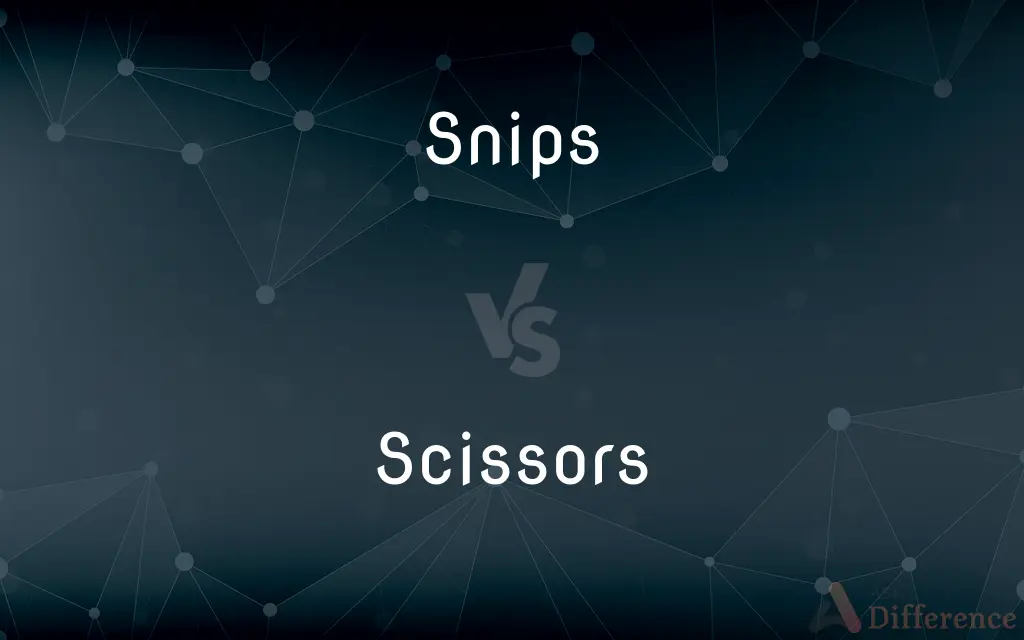Snips vs. Scissors — What's the Difference?
By Tayyaba Rehman & Maham Liaqat — Updated on April 4, 2024
Snips are specialized tools designed for cutting specific materials like metal, featuring long handles for leverage, while scissors consist of two pivoting blades and are versatile for cutting various materials like paper and fabric.

Difference Between Snips and Scissors
Table of Contents
ADVERTISEMENT
Key Differences
Snips are tailored for heavy-duty tasks, especially in metalwork, where precision and strength are required to cut through materials like sheet metal and ductwork. They come in various designs, including straight, left, and right-cutting types to navigate around tight spaces and corners. Scissors, on the other hand, are a more universal cutting tool used in homes, schools, and crafts. Their design is simple yet effective for cutting softer materials such as paper, cloth, and thin plastic, making them essential in everyday tasks and creative projects.
The design of snips includes long handles and short blades, providing the mechanical advantage necessary for cutting through tough materials with less effort. This contrasts with scissors, where the handles and blades are more balanced in length, designed for precision and control over the cutting of soft materials. The leverage gained from snip handles allows for more forceful cutting with less hand fatigue.
Snips are often made from high-carbon steel, making them durable enough to withstand the demands of cutting metal without dulling quickly. Scissors, while also made from various types of metals, including stainless steel, prioritize sharpness and ease of use. The material choice for scissors reflects their general-purpose nature and the need for a clean cut on a variety of household materials.
The blades of snips may be serrated or have special coatings to grip the material being cut, reducing slippage and making the cutting process smoother and safer. In contrast, scissors typically have straight, sharp blades ideal for making straight and precise cuts. The serration on snips' blades is particularly useful for cutting through slippery materials like metal, where precision is crucial.
Snips are categorized by their cutting direction (straight, leftwards, or rightwards) and their specific use (such as aviation snips for cutting thin sheet metal). This categorization aids users in selecting the right tool for their project, ensuring efficient and safe cutting. Scissors, while not typically categorized by cutting direction, come in various forms, including general-purpose, fabric, and kitchen scissors, each designed to best suit the material they are intended to cut.
ADVERTISEMENT
Comparison Chart
Primary Use
Cutting metal and other tough materials
Cutting paper, fabric, and general-purpose materials
Blade Design
Short blades with long handles for leverage
Balanced blades and handles for controlled cuts
Material
High-carbon steel for durability
Stainless steel for sharpness and durability
Blade Type
Often serrated or specially coated
Typically straight and sharp
Cutting Direction
Categorized by cutting direction (straight, left, right)
Not typically categorized by cutting direction
Compare with Definitions
Snips
Tools designed for cutting metals, featuring leverage-enhancing long handles.
Using snips, he easily cut through the sheet metal for the project.
Scissors
Blades are straight and sharp for precise cuts.
The sharp blades of the scissors made clean cuts on the wrapping paper.
Snips
Available in designs for straight, left, or right cuts.
For the intricate metalwork, she selected right-cutting snips.
Scissors
Universal cutting tools for paper, fabric, and more.
She used sharp scissors to cut out the intricate paper design.
Snips
Blades may be serrated for better material grip.
The serrated blades of the snips made cutting through the ductwork smoother.
Scissors
Have balanced handles and blades for precision.
The scissors were perfectly balanced, making fabric cutting effortless.
Snips
Often made from high-carbon steel.
The high-carbon steel snips remained sharp even after repeated use.
Scissors
Come in various forms like fabric and kitchen scissors.
For the sewing project, she chose fabric scissors for their precision.
Snips
Categorized by cutting direction for specific tasks.
He used straight-cut snips for the long, straight sections of the installation.
Scissors
Typically made from stainless steel.
The stainless steel scissors cut through the ribbon smoothly.
Snips
Snips, also known as shears, are hand tools used to cut sheet metal and other tough webs. There are two broad categories: tinner's snips, which are similar to common scissors, and compound-action snips, which use a compound leverage handle system to increase the mechanical advantage.
Scissors
Scissors are hand-operated shearing tools. A pair of scissors consists of a pair of metal blades pivoted so that the sharpened edges slide against each other when the handles (bows) opposite to the pivot are closed.
Snips
To cut, clip, or separate (something) with short, quick strokes.
Scissors
To cut or clip with scissors or shears.
Snips
To cut or clip with short, quick strokes.
Scissors
Scissors (used with a sing. or pl. verb) A cutting implement consisting of two blades joined by a swivel pin that allows the cutting edges to be opened and closed.
Snips
An instance of snipping or the sound produced by snipping.
Scissors
Any of various gymnastic exercises or jumps in which the movement of the legs suggests the opening and closing of scissors.
Snips
A small cut made with scissors or shears.
Scissors
A scissors hold.
Snips
A small piece cut or clipped off.
Scissors
A tool used for cutting thin material, consisting of two crossing blades attached at a pivot point in such a way that the blades slide across each other when the handles are closed.
Scissors are used to cut the flowers.
Use scissors to cut them if you don't have proper shears.
Snips
A bit or scrap
Snips of information about the merger.
Scissors
A type of defensive maneuver in dogfighting, involving repeatedly turning one's aircraft towards that of the attacker in order to force them to overshoot.
Snips
One that is small or slight in size or stature.
Scissors
An instance of the above dogfighting maneuver.
Snips
A person regarded as impertinent or mischievous.
Scissors
An attacking move conducted by two players; the player without the ball runs from one side of the ball carrier, behind the ball carrier, and receives a pass from the ball carrier on the other side.
They executed a perfect scissors.
Snips
Snips (used with a sing. or pl. verb) Hand shears used in cutting sheet metal.
Scissors
A method of skating with one foot significantly in front of the other.
Snips
(Slang) Something easily accomplished.
Scissors
An exercise in which the legs are switched back and forth, suggesting the motion of scissors.
Snips
Plural of snip
Scissors
A scissors hold.
Snips
Shears; hand tools used to cut sheet metal and other tough webs
Scissors
(rock paper scissors) A hand with the index and middle fingers open (a handshape resembling scissors), that beats paper and loses to rock. It beats lizard and loses to Spock in rock-paper-scissors-lizard-Spock.
Snips
(plural) hand shears for cutting sheet metal
Scissors
(rare) scissor
Scissors
(transitive) scissor
Scissors
(dated) Cry of anguish or frustration.
Scissors
A cutting instrument resembling shears, but smaller, consisting of two cutting blades with handles, movable on a pin in the center, by which they are held together. Often called a pair of scissors.
Scissors
And edge tool having two crossed pivoting blades
Scissors
A wrestling hold in which you wrap your legs around the opponents body or head and put your feet together and squeeze
Scissors
A gymnastic exercise performed on the pommel horse when the gymnast moves his legs as scissors move
Common Curiosities
How do I choose between snips or scissors?
Choose based on material: snips for metal and tough materials, scissors for paper, fabric, and general cutting tasks.
Can scissors be used to cut metal?
While some heavy-duty scissors may cut thin metals, they're generally not designed for metalwork like snips.
Are there different types of snips?
Yes, there are straight, left-cutting, and right-cutting snips, each designed for specific cutting directions and tasks.
Can I use fabric scissors on paper?
It's not recommended as cutting paper can dull the blades, making them less effective for fabric.
What are snips used for?
Snips are primarily used for cutting metals such as sheet metal, ductwork, and metal straps.
Are all scissors suitable for left-handed users?
No, but specific left-handed scissors are designed to be more comfortable and effective for left-handed users.
What makes aviation snips different?
Aviation snips are designed for cutting thin sheet metal, featuring compound leverage for easier cutting.
How do I maintain my snips and scissors?
Clean after use, store in a dry place, and sharpen the blades as needed to maintain their effectiveness.
Can snips cut through nails?
Some heavy-duty snips can cut through small nails, but it's essential to use the correct type to avoid damage.
Why do snips have long handles?
Long handles provide greater leverage, making it easier to cut through tough materials with less effort.
What's the difference between tin snips and aviation snips?
Tin snips are traditional metal-cutting tools for straight cuts, while aviation snips are more versatile, designed for cutting curves and angles in thin metal.
Are scissors safe for children to use?
Yes, there are specially designed safety scissors for children with rounded tips and ergonomic handles for safe use.
Can I sharpen snips and scissors myself?
Yes, but it requires specific techniques and tools to ensure the blades are sharpened correctly.
Do snips work on all types of metal?
Snips are effective on many metals but selecting the right type for the material's thickness and hardness is crucial.
How often should I replace my snips or scissors?
With proper care, they can last many years. Replace when they no longer perform their function effectively despite maintenance.
Share Your Discovery

Previous Comparison
Construct vs. Construction
Next Comparison
Place vs. PlazaAuthor Spotlight
Written by
Tayyaba RehmanTayyaba Rehman is a distinguished writer, currently serving as a primary contributor to askdifference.com. As a researcher in semantics and etymology, Tayyaba's passion for the complexity of languages and their distinctions has found a perfect home on the platform. Tayyaba delves into the intricacies of language, distinguishing between commonly confused words and phrases, thereby providing clarity for readers worldwide.
Co-written by
Maham Liaqat















































